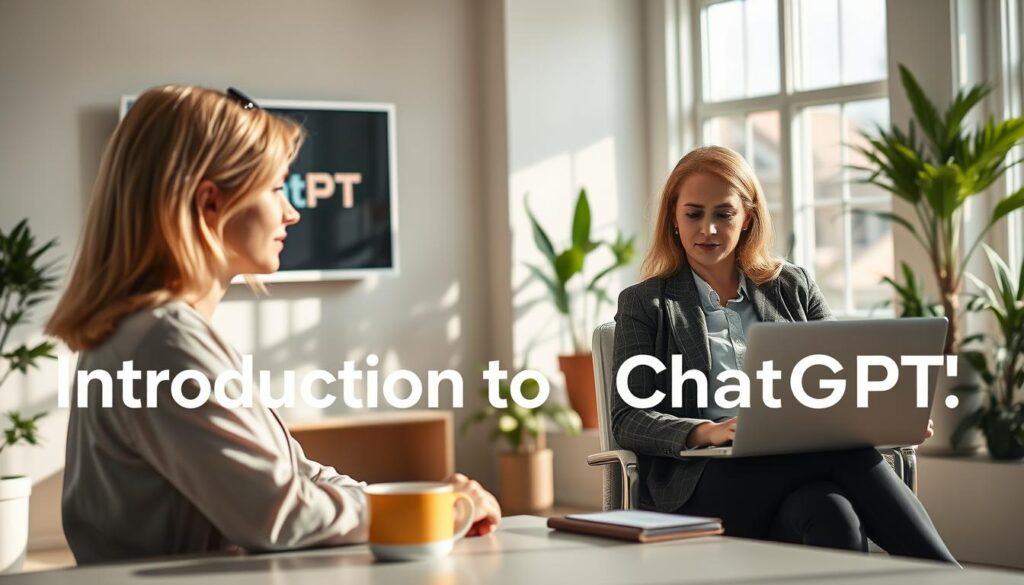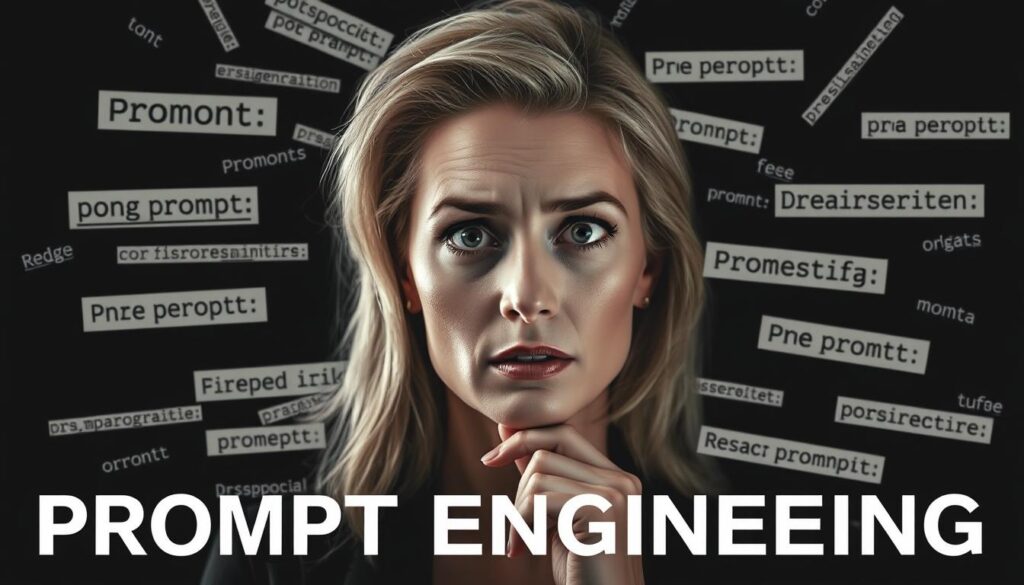Clarity, specificity, and context are key to getting the most out of ChatGPT. People often ask about good prompts for chatgpt to get more precise answers. Giving clear instructions or a specific style can make each response better.
Prompt writing, or prompt engineering, adds structure and reduces uncertainty. Even small changes can lead to big improvements. This introduction sets the stage for more strategies and encourages you to craft queries that meet your needs.
Key Takeaways
- Use clear language for direct answers
- Include enough context for focus
- Set a style or tone for desired output
- Provide specific details to guide the model
- Create prompts that match your true intent
- Experiment and refine for better results
Introduction to ChatGPT
ChatGPT from OpenAI is changing how we use technology. It can write poetry, handle code, and do many tasks. People find it great for brainstorming and bringing their ideas to life.

Explore its capabilities by checking out this useful resource. Each prompt leads to deeper conversations. This results in sharper insights and thoughtful ideas.
The Evolution of Conversational AI
Old chatbots couldn’t understand much and gave the same answers over and over. Now, with transformer-based models, we have deeper conversations. ChatGPT excels in these, keeping track of instructions and following up well.
Key Features of ChatGPT
It can make lists, tables, and even code blocks. It can also write in a specific style or tone. This makes it useful for outlining, writing stories, and finding new ways to solve problems.
Why Prompt Quality Matters
Prompt engineering is key to getting the most out of ChatGPT. A well-written question helps ChatGPT give accurate answers. This makes it easier and faster for users.
Good prompts help ChatGPT solve problems or create content better. Bad prompts can lead to unclear answers. But, clear details on what you need help with lead to better results. This is important for writing good blog posts or coming up with new ideas.

| Prompt Strategy | Benefit |
|---|---|
| Define Your Goal | Narrows down specific responses |
| Provide Context | Guides the AI toward relevant details |
| Set Clear Limits | Prevents lengthy or off-track replies |
what are good prompts for chatgpt
When you ask ChatGPT a question, being clear and specific is key. A few well-chosen words can help the system give you the right answer. Good questions not only tell the system what to talk about but also how to talk about it.
Many people find that effective ChatGPT prompts come from using clear language and real-life examples. This makes the answers feel natural and easy to understand.

Defining Good Prompts
Every question should have a clear purpose. You might want data in a specific format, creative ideas, or simple answers. Adding a bit of background information can help the model find the exact information you need.
Changing the length or the audience of your question can also make the answers more relevant.
Example of Weak vs. Strong Prompts
Questions that are too vague often get answers that are not very helpful. But, adding the right context can lead to much deeper insights. Here’s a quick look at the difference:
| Prompt Type | Example |
|---|---|
| Weak Prompt | “Tell me something about marketing.” |
| Strong Prompt | “Compose a 150-word overview on digital marketing trends, highlighting three emerging tools for small businesses.” |
Tips for Clarity and Context
Good communication starts with clear goals. Planning well helps ChatGPT understand what you need. This is key to getting answers that fit your needs.

Setting the Scene
Creating a detailed setting makes your content more real. For example, imagine a busy café where an entrepreneur meets investors. This setting helps the AI give more relevant insights.
Including Specific Objectives
Being clear about what you want helps get better results. You might ask for a brief summary or a persuasive story. Each goal helps ChatGPT give you clear, useful answers.
The Role of Tone and Style
Brand identity often depends on tone. Some people like playful language with warmth and humor. Others prefer a formal voice for professionalism. ChatGPT can adjust to fit your style, making each sentence unique.
Asking for a specific flair can make your writing feel like Ernest Hemingway or Shakespeare. Short sentences can make your content feel light and easy. On the other hand, bigger words and dramatic phrases add depth to technical topics. Trying out different synonyms and phrases shows how your content can change to match your voice.

| Style Approach | Key Trait | Example Outcome |
|---|---|---|
| Hemingway-Inspired | Concise and clear | Direct sentences with minimal flair |
| Shakespeare-Inspired | Poetic language | Flowery phrases and dramatic emphasis |
| Professional Tone | Neutral voice | Formal word choice and precise details |
Tailoring Prompts for Different Use Cases
Businesses and authors face unique challenges. ChatGPT is ready to help with marketing pitches and storylines. By experimenting, you can get more specific answers. Starting with ChatGPT conversation tips can lead to better results.

Brainstorming Sessions
Teams looking for new ideas can ask for many suggestions. For example, ask for ten creative slogans for a restaurant. Mentioning your brand style helps ChatGPT give ideas that start discussions.
Problem-Solving Strategies
For complex problems, ask for a detailed list of pros and cons. Share your challenges, like tight budgets or new markets. This helps ChatGPT suggest cost-effective solutions or timelines. Adding ChatGPT conversation tips to your prompt can improve the response.
Creative Writing Scenarios
Writers can add style or character details to their prompts. If you want a unique twist in a fantasy story, include specific plot points. This tells ChatGPT to create themes, endings, or surprises. The right prompt leads to better narrative support.
Avoiding Open-Ended Queries
Unstructured prompts often lead to broad, surface-level answers. A question like “Tell me about an entire marketing plan” might seem good. But it usually gets you generic details. When you want a specific answer, clarity is key.

Pitfalls of General Questions
General questions can limit what AI models can do. They give you safe, but shallow answers. This can be a problem if you need detailed, data-driven information.
You might end up asking for more details. This can waste your time.
How to Narrow Down Query Scope
Ask specific questions to get the AI’s full attention. Include specific goals or timeframes. For instance, ask for a few proven tactics or a short list of recommendations for a specific audience.
Being precise helps avoid guesswork. It gives you more useful results.
Advanced Techniques for Elite Prompts
Elite prompt design is more than just asking for something. It needs special methods that spark creativity and clearness. The best ChatGPT prompts are those that ask for specific roles or exact instructions, with little room for error.

Leveraging Role-Play Prompts
Role-play makes AI responses feel real. When you tell ChatGPT to be an HR manager or a comedian, it responds with genuine words. This method creates dynamic results that match the audience’s needs.
Using System Messages for Precision
System messages guide ChatGPT before it starts. They set clear rules about format, tone, or word count. This focus helps avoid unnecessary detours and gives prompt answers that meet exact requirements.
| Technique | Key Benefit |
|---|---|
| Role-Play | Engaging dialogue from chosen perspectives |
| System Messages | Sharper directions with consistent results |
Common Mistakes to Watch Out For

Some prompts don’t work well when they’re missing important details. The AI might give answers that aren’t what you wanted. It’s crucial to be clear and specific, but sometimes we’re not.
When we ask for too much at once, it can confuse ChatGPT. This leads to unclear text. It’s better to break tasks into smaller parts. This keeps the conversation on track and improves the results.
Not giving clear instructions or a solid structure can also cause problems. Good prompts should clearly state what you need, like a news release or data summary. Being clear, moderate, and open to changes is key. Getting feedback quickly helps make things better.
| Mistake | Consequence |
|---|---|
| Vague Context | Generic responses with minimal relevance |
| Multiple Goals | Confusion and fragmented output |
| No Feedback | Repeated faults that linger |
Testing and Iterating on Prompts
Even the best-looking prompts can have hidden flaws. Early tests show where they need work. With each update, they become better at guiding AI responses.

Getting feedback from users is key. Small changes in wording can make a big difference. Trying new things often leads to new ideas.
Gathering Feedback
Reviews from peers and surveys from users are very helpful. Seeing how people react to prompts can reveal issues. Focus groups help pinpoint any confusion caused by the wording.
Analyzing Prompt Performance
Using consistent metrics helps improve prompts. These metrics might include how happy users are, how fast the AI responds, and how clear the answers are. Breaking down the data helps refine prompts better.
“Regular testing ensures clarity and fosters user confidence.”
Thanks to ongoing feedback, teams keep making prompts better. They adapt to new needs without losing accuracy. This keeps prompts versatile and effective.
Testing and Iterating on Prompts
Improving prompts is key to getting the right answers. It’s rare for the first try to meet all needs. Adjustments are needed for tone, length, or context. This makes prompts better by finding areas for improvement.
Each tweak is guided by careful reviews. This helps move forward in a positive way.
Gathering Feedback
Feedback from others is crucial. Peers, clients, or advisors can give great insights. They help figure out what works and what doesn’t.
Surveys or quick chats can also provide valuable feedback. Even small suggestions can help shape the next version. This ensures prompts match the brand and user expectations.

Analyzing Prompt Performance
Success is often measured by results like higher engagement. Creators might focus on brand voice or conversions. Each change tests a new approach.
They look at things like tables, code, or style. This process refines prompts until they offer a seamless chat experience.
Real-World Success Stories
Small companies and big brands have found success with ChatGPT. Shopify store owners use it to make catchy product listings. They don’t need to hire expensive copywriters.
HubSpot marketing teams use ChatGPT for social posts and email drafts. They focus on precision. Each project starts with clear goals and a specific audience in mind.
Nike is another example. They use AI for new content ideas, especially for seasonal collections. This saves time and brings new ideas to the table.

These stories highlight how simple prompts can change workflows. Teams can come up with new ideas in minutes. They can test different angles without wasting time.
This leads to more original content. It keeps up with the fast pace of today’s market.
Tools and Resources for Prompt Crafting
Making great queries can change any AI chat. Special platforms help, with examples, support, and new ideas. They make crafting prompts easier.

Prompt Libraries
There are big collections of pre-made prompts for different needs. Some are for tech tasks, like coding and debugging. Others are for marketing or teaching.
Each library is sorted by topic. This makes it easy to find prompts that fit your goals.
- GitHub repositories with diverse prompt samples
- OpenAI forums showcasing community-tested scripts
- Educational hubs that highlight learning-based content
Online Communities
People meet in groups on Reddit, LinkedIn, and forums. They share what works and what doesn’t. This helps everyone learn and grow.
Getting feedback on prompts keeps people motivated. It also leads to new ideas. Being part of these groups helps you improve and connect with others.
The Future of Prompt Writing
Prompt strategies are on the verge of big changes. AI models are getting better, making prompt writing an art that blends clarity and creativity. ChatGPT is adding depth to text-based responses with its smart features.

New developments suggest a shift towards multi-modal interactions. This means prompts will include audio and images. It makes conversations richer by engaging more senses.
Role-based techniques are also becoming popular. They let users assign roles or personas for more realistic responses.
Generative Engine Optimization could change how brands and creators use AI. With real-time data, including ChatGPT’s updates, results will be faster and more accurate. Google Gemini could bring even more advanced capabilities, offering complex analysis and deeper context.
These trends point to a bright future for those interested in responsive, intuitive dialogue. Knowing how to use AI tools well is crucial for creating effective prompts.
Conclusion
Smart prompt design helps everyone, from small business owners to creative writers, get more from ChatGPT. Clear instructions and context lead to deeper answers. Setting specific goals, like word count or tone, makes prompts more focused.
The process is adaptable. After trying a few prompts, making changes can lead to new ideas or solutions. Every small tweak can open up new possibilities.
Staying up-to-date with new techniques and tools keeps prompt creation exciting. Many success stories show how this approach leads to progress in various fields. Keep experimenting, track your results, and refine your prompts until they meet your goals. In the fast-changing world of AI, well-crafted prompts lead to amazing interactions.

